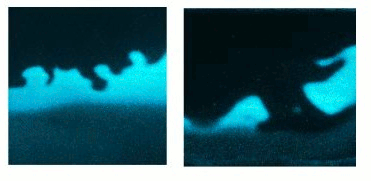
Back to Table of Contents
46991-AC9
Experiments on Strained Premixed Flames in the Distributed Reaction Regime
Alessandro Gomez, Yale University
Highly turbulent premixed
flames have been stabilized in a countercurrent configuration. The flames are
established by counterflowing a hot combustion product stream from a separate
burner to a stream of fresh, premixed reactants. A properly designed and positioned
high-blockage plate is used to generate high turbulent Reynolds numbers,
preserving flow homogeneity. Stable flames at bulk strain rates up to 1.3 103
of s-1 could be stabilized resulting in turbulent Reynolds numbers
(Re) up to 1.3 103 and Karlovitz numbers (Ka) ranging from 1.5 to
400, depending on the strain rate and the flame stoichiometry. In turbulent
premixed combustion, experimental investigation of the non-flamelet regime,
often called broken reaction zone regime or distributed reaction zone regime,
still remains an open challenge. The non-flamelet regime corresponds to a
situation of discontinuous flame sheets locally extinguished by turbulent
eddies and is expected in very intense turbulence, at turbulent Karlovitz
number greater than 100. Conditions of strong turbulence and chemistry
interaction are particularly hard to reproduce in a laboratory-scale burner and
rare evidence of the non-flamelet regime under such conditions has been
reported to date. Furthermore, in practical combustors and engines, additional
factors, such as volumetric heat loss in the vicinity of walls, intense strain
rate imposed by the mean convective flow field or local mixing of the reactants
with combustion products, can contribute to reduce the heat release rate, which
eventually may lead to local extinction by turbulence and possible re-ignition.
In this project we demonstrated how highly turbulent flames with real flame
effects, such as heat losses and high strain rates, can be established in a
compact, bench-top experiment, that is amenable to computational modeling and
even direct numerical simulation. The configuration shows a rich phenomenology,
which make it the ideal target for model testing.
Six
flames were considered (A-F) and the phenomenological appearance of two of them
is shown in Fig. 1 via OH Planar Laser Induced Fluorescence (PLIF). In each
picture we notice: a dark region on the top, corresponding to the cold reactant
part of the domain in which no OH can be detected; a relatively weak signal
diffused throughout the bottom stream, as a result of the fact that under the
high temperature of the hot combustion products OH is present in small
concentrations; between these two regions, one can notice brighter region(s) in
all but the last picture that can be attributed to the OH generated by
 the turbulent premixed flame. The picture
on the left shows a stoichiometric CH4/air flame at a strain rate of
980 s-1 , Re= 670 and Ka= 1.5. The flame is singly connected and wrinkled. The
picture to the rights shows OH PLIF for a flame with the same strain rate and
Re, but at lower equivalence ratio F=0.7, which doubles Ka, weakens the flame and causes local
extinction. Despite the modest Ka, it should fall in the non-flamelet regime.
Yet, the OH evidence of local extinction, suggests otherwise.
the turbulent premixed flame. The picture
on the left shows a stoichiometric CH4/air flame at a strain rate of
980 s-1 , Re= 670 and Ka= 1.5. The flame is singly connected and wrinkled. The
picture to the rights shows OH PLIF for a flame with the same strain rate and
Re, but at lower equivalence ratio F=0.7, which doubles Ka, weakens the flame and causes local
extinction. Despite the modest Ka, it should fall in the non-flamelet regime.
Yet, the OH evidence of local extinction, suggests otherwise. The
so-called extended Borghi diagram is used to identify various turbulent
combustion regimes, with turbulent velocity and integral length scales normalized
with respect to the laminar flame speed and the flame thickness (Fig. 2). Six
flames were considered, A-F. Scaling considerations would suggest that Flames A, B, C and E fall in the
flamelet regime, whereas Flame D should belong to the non-flamelet regime.
Because of strain and heat losses, also Flames C and F fall outside the
flamelet regime in the broken/distributed reaction zone regime, whereas “Flame”
E can not even be supported. The fact that Flame E with virtually identical
position in the figure as Flame C is not burning is tentatively attributed to
differences in CO concentration because of the different stoichiometry and
different impact of the incomplete conversion to CO2 at these high
strain rates. Clearly, the extended Borghi diagram is an idealization that does
 not account for the effect of strain and heat
losses, both of which are present in practical systems. The present burner
allows for a systematic examination of these effects and should enable us to
redraw a modified Borghi diagram accounting for these “realities” and
redefining the boundaries of the various regimes. Also noteworthy is the fact that the achievable experimental
conditions for these premixed flames overlap part of the domain of IC engines.
not account for the effect of strain and heat
losses, both of which are present in practical systems. The present burner
allows for a systematic examination of these effects and should enable us to
redraw a modified Borghi diagram accounting for these “realities” and
redefining the boundaries of the various regimes. Also noteworthy is the fact that the achievable experimental
conditions for these premixed flames overlap part of the domain of IC engines.



